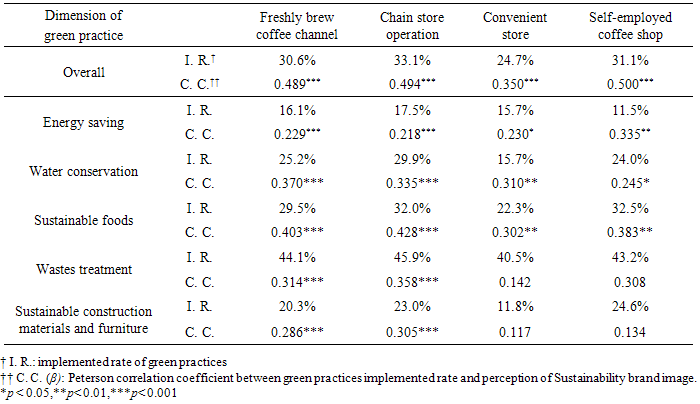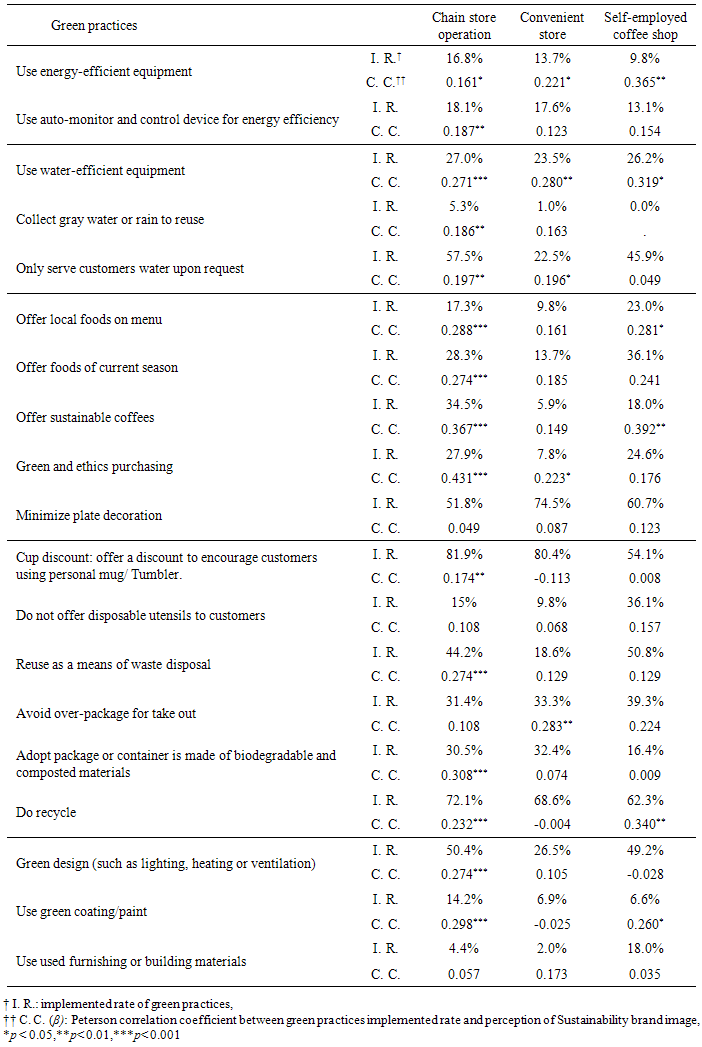-
Paper Information
- Next Paper
- Previous Paper
- Paper Submission
-
Journal Information
- About This Journal
- Editorial Board
- Current Issue
- Archive
- Author Guidelines
- Contact Us
American Journal of Tourism Management
p-ISSN: 2326-0637 e-ISSN: 2326-0645
2015; 4(2): 35-39
doi:10.5923/j.tourism.20150402.02
The Study of the Relationship between Store Green Practices and Consumer’s Perception of Sustainability Brand Image toward Coffee Store
Joseph Si-Shyun Lin, Herman Hung-Sheng Lai, Hao-Yuan Chen
Department of Restaurant, Hotel and Institutional Management, Fu-Jen Catholic University, R. O. C.
Correspondence to: Joseph Si-Shyun Lin, Department of Restaurant, Hotel and Institutional Management, Fu-Jen Catholic University, R. O. C..
| Email: |  |
Copyright © 2015 Scientific & Academic Publishing. All Rights Reserved.
This study examined how customers perceive store green practices and the relationship with their perception of sustainability brand image towards coffee stores. Due to the increasing awareness of the impact of global warming in private and public sectors and thereby the increased eco-awareness of consumers, the concept of sustainability has been gaining its momentum in the foodservice industry. Coffee outlet, as a promising foodservice business in Taiwan, is encouraged to initiate green approaches in their stores. It is assumed that the green initiatives from the coffee stores are supported by consumers and considered as an added value to the brands. However, no related research has been conducted to reveal the relationship. Therefore, the purpose of this study was attempted to find out whether green practices have strong effects on the sustainability brand image of coffee stores, and how consumers perceive green practices in response to the sustainability image of coffee brands of different business models. A total of 389 responses indicated that ‘waste treatment’ dimension was the most implemented practices in coffee channels (44.1%) among all green practices, followed by ‘Sustainable foods’ (29.5%), ‘Water conservation’(25.2%), ‘Sustainable construction material and furniture’(20.3%), and ‘Energy saving’(16.1%). The results of the study also confirmed that customers’ perception of implemented green practices have a positive effect on the sustainability image of the coffee brand. The contents and levels of green practices implemented, however, had different responses to the perceived sustainability brand image of coffee stores. It is also interesting to found that participants perceived the green practices most related to the sustainability image for chain operation brands, where the practice of ‘offer sustainable coffees and local foods’ was the best contributor to their sustainability image. Managerial implications were suggested to coffee store operation that, with proper implementation of green practices, coffee stores can enhance their sustainability brand image. Further study examining the influence of coffee store sustainability brand image on consumers’ perceived value and behavior intention will be conducted.
Keywords: Green practices, Sustainability brand Image, Coffee channels
Cite this paper: Joseph Si-Shyun Lin, Herman Hung-Sheng Lai, Hao-Yuan Chen, The Study of the Relationship between Store Green Practices and Consumer’s Perception of Sustainability Brand Image toward Coffee Store, American Journal of Tourism Management, Vol. 4 No. 2, 2015, pp. 35-39. doi: 10.5923/j.tourism.20150402.02.
1. Introduction
- Coffee is the second largest commodity and the largest agricultural produce in the world. The global coffee production of 2013 has reached 144,611,000 bags, which the number has increased 24% since 2008 (ICO, 2013). It is estimated that approximately 1.6 billion cups of coffee were consumed each day worldwide, and this market has keep growing at the rate of 12% to 15% every year (Taiwan fair-trade association, 2014). According to the data from Taiwan chain stores and franchise association, the coffee business of Taiwan was fifty billion NT dollars in 2012, which has grown 30% as compared to the one in previous year (TCFA, 2013). The coffee consumption per capital in Taiwan is about 100 cups per year, which is twice the number 15 years ago (Yang, 2013). Drinking coffee has gained its popularity and become part of an everyday routine to many people in Taiwan.Recently, coffee shops have popped out on the streets to meet the demands of the growing market in Taiwan. Coffee bands from oversea (i. g. Starbucks, illy, Gloria jeans, etc.) as well as local have joined the battle field. In 2013, there are 70 chain operation coffee brands in Taiwan, which the number of coffee brand has grown almost 15% as compared to 2012. Along with the chain operation brands, it is estimated that around 8000 self-employed coffee shops are also in service (TCFA, 2014). Beside regular coffee stores, the competitors from other sectors, such as convenient stores (i. g. 7-11 and Family mart), fast food and super markets, who provide freshly brew coffee at fair price are also important players in the market.With the growing market and yet a competitive business, chain coffee brand like Starbucks emphasize their global team efforts and legendary service, while local brands (such as Cama coffee and 85C) and some self-employed coffee shops stress the freshness of coffee, delicious foods, exclusive designs and experiences, or fair price. Therefore, it is an important task for these players to attract their loyal consumers and consolidate their brands in the market.Recently, due to the increasing awareness of the impact of global warming in private and public sectors and thereby the increased eco-awareness of consumers, the concept of sustainability has been gaining its momentum in the foodservice industry. Research showed that, besides a value-over-price experience, consumer nowadays also expect the companies to provide their products and services with less or no impact to the environment and society (Liao, 2009; Chien, 2011). Therefore, it becomes more and more important that company (especially foodservice business) to accommodate environmental friendly programs such as using energy and water-conserve facilities, or waste recycling and reuse to their operations (Alexander & Kennedy, 2002; GRA, 2010; Jurowski, 2003), so as to differentiate themselves from competitors to acquire consumer’s trust and preferences (Hu et al., 2010; Yesowich, 2009; Namkung & Jang, 2014). Companies accommodate green practices to their operation to show their commitments to environmental concern and social supports and, consequently, enhance their brand image to consumers (Chen, 2009; Namkung & Jang, 2010; Tan & Yeap, 2012). The perceived image of the company, which could be considered as the ‘Sustainability brand image’ is different from ‘Green brand image’; the company has deliver its concern not only to environmental protection but also to social supports (for example, the welfare of the farmers/workers) while providing its products or services to consumers (Belz & Peattie, 2009).Coffee outlet, as a promising foodservice business in Taiwan, is encouraged to initiate green approaches. It is indicated that the green initiatives from the foodservices have been supported by consumers and considered as an added value to the brands (Penny, 2007; Han, Hsu, & Lee, 2009; Lee, Hsu, Han, & Kim, 2010). However, no related research has been conducted to reveal the relationship in coffee business. Therefore, the purpose of this study was attempted to find out whether green practices have strong effects on the sustainability brand image of coffee stores, and how consumers perceive green practices in response to the sustainability image of coffee brands of different business models.
2. Method
- Research was conducted in Taiwan areas. Convenience sampling of freshly brew coffee drinkers were asked to fill out the questionnaire. Participants were asked to write down the name of the coffee channel of their last purchasing and then record their perceptions of the green practices implemented in the coffee channel and the Sustainability brand image accordingly. In the end, three hundred and eighty nine valid questionnaires out of four hundred and fifty were obtained. The construct of ‘Green practice of coffee channel’ are modified from the studies of green practices in restaurants by Jeong & Jang (2010), Hu (2014) and Wang (2012). It includes dimensions of ‘energy saving’, ‘water conservation’, ‘wastes treatment’, ‘sustainable foods’, and ‘sustainable construction materials’. Participants were asked to mark ‘Implemented’, ‘Not implemented’ or ‘No idea’ on each of the listed 19 green practices, according to their perception of the implementation of these practices to this designated coffee channel. The percentage of the green practices implemented in the coffee channel was calculated. The implemented rate of each proposed green practice was also calculated by consolidating the data from all participants. The ‘Sustainability brand image’ of the coffee channel was modified from the ‘Green brand image’ of restaurant constructed by Namkung & Jang (2014). It was used as the instrument to interpret the participant’s perception of the sustainable image of these coffee brands. It includes the brand’s performance in environmental conservation and social support (for example, ‘I regard this coffee channel as a benchmark/standard of environmental commitment’ and ‘This coffee channel is professional in terms of its social support reputation’). The perception of sustainability brand image of the participants were measured by using a Likert-type rating scale from ‘‘1: the least agree’’ to ‘‘7: very much agree’’. The method of Peterson correlation was executed to analyze the relationship between the levels and contents of green practices implemented and the perceived sustainability brand image toward coffee channels.
3. Results and Discussion
- Reliability check by Factor analysis showed that the construct displayed ample reliability with factor loadings exceeding 0.80 for the scales of Sustainability brand image. It is found that the dimension of ‘Waste treatment’ was perceived the most implemented practices in these coffee channels (44.1%), followed by ‘Sustainable foods’ (29.5%), ‘Water conservation’(25.2%), ‘Sustainable construction materials and furniture’ (20.3%), and ‘energy saving’(16.1%) (Table 1). Among the studied business models, chain store brands and self-employed coffee stores had similar implemented rate (33.1% and 31.1%, respectively) while convenient store was perceived to have the lowest rate (24.7%).
|
|
4. Conclusions
- The results of this study revealed that participant’s perception of implemented green practices have positive effects on the sustainability image of the coffee brand. The contents and levels of green practices implemented, however, had different responses to the perceived sustainability brand image of coffee store. It is also found that participants did perceive green practices differently in response to the sustainability image of coffee brands towards different business models. They considered the green practices most related to the sustainability image for chain operation brands, while convenient store had the lowest correlation.Therefore, it is clear to the brand owners that they could increase consumer’s perception of their Sustainability brand image by implementing green practices in the coffee stores. Coffee channels are encouraged to prioritize their resources in ‘Sustainable foods’ that they can offer sustainable coffees, purchase local and on-season foods, and take the initiative of green and ethic purchasing’, waste-recycle, and using energy and water efficiency equipments. Besides, it is also important, for both public and private sectors, to explain the multi-dimensional green practices in coffee business, and communicate to the consumers the urgency and consequence of their implementation.Further study examining the influence of coffee store sustainability brand image on consumers’ perceived value and behavior intention will be conducted.
 Abstract
Abstract Reference
Reference Full-Text PDF
Full-Text PDF Full-text HTML
Full-text HTML
